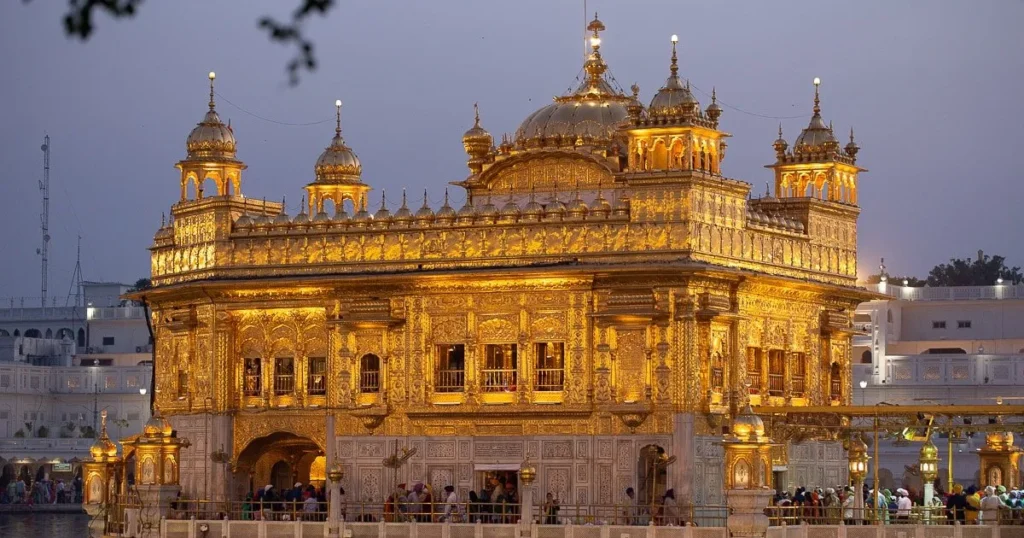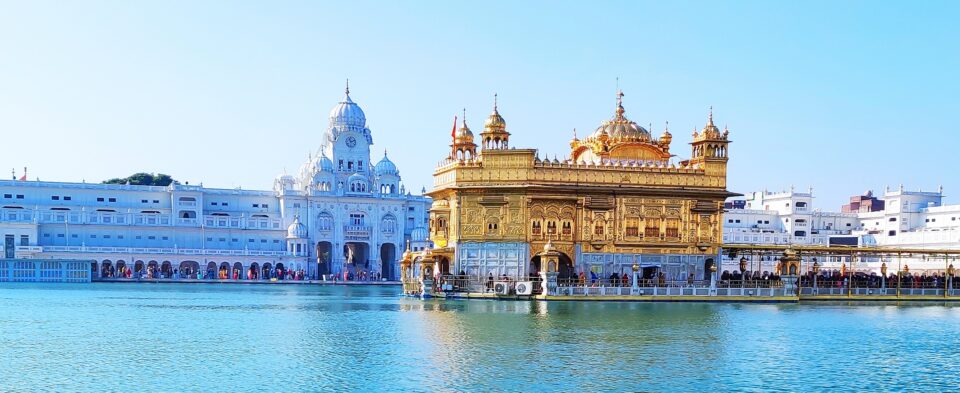Amritsar, a city steeped in history and spirituality, is one of India’s most significant cultural hubs. Located in the northwestern state of Punjab, Amritsar is renowned for its rich heritage, vibrant traditions, and iconic landmarks. This blog explores the multifaceted charm of Amritsar, delving into its historical significance, cultural vibrancy, and spiritual essence.
Historical Significance: A Glimpse into Amritsar’s Past
Amritsar’s history is deeply intertwined with the Sikh religion. Founded in 1577 by the fourth Sikh Guru, Guru Ram Das, the city has been a focal point for Sikhism ever since. The most iconic landmark of Amritsar is the Golden Temple, or Harmandir Sahib, which attracts millions of visitors from around the globe. This stunning structure, with its gleaming gold facade, stands as a testament to Sikh devotion and architectural prowess.

The city has witnessed numerous significant historical events. The Jallianwala Bagh massacre of 1919, where hundreds of unarmed Indians were killed by British troops, marks a somber chapter in India’s struggle for independence. Today, Jallianwala Bagh is a poignant memorial, reminding visitors of the sacrifices made for India’s freedom.
Cultural Vibrancy: Festivals, Food, and Traditions
Amritsar is a cultural mosaic, where age-old traditions blend seamlessly with modernity. The city comes alive during festivals like Baisakhi, which marks the Sikh New Year and the harvest festival. The celebrations are characterized by vibrant processions, traditional dances like Bhangra, and an outpouring of community spirit.
The cuisine of Amritsar is a gastronomic delight, reflecting the rich culinary heritage of Punjab. From the famous Amritsari Kulcha to the delectable Makki di Roti and Sarson da Saag, the food here is a symphony of flavors. The city’s bustling food streets, such as Lawrence Road and Katra Jaimal Singh, offer a plethora of mouth-watering options that cater to every palate.
Spiritual Essence: The Heartbeat of Amritsar
At the heart of Amritsar’s spiritual life is the Golden Temple, a beacon of peace and devotion. The temple’s serene environment, combined with the soulful recitation of Gurbani (Sikh hymns), provides a tranquil refuge for the soul. The Amrit Sarovar, the holy tank surrounding the temple, is believed to have healing powers and is central to the temple’s spiritual experience.
Another notable site is the Akal Takht, the highest seat of earthly authority for Sikhs, located within the Golden Temple complex. It serves as a crucial center for the community’s political and religious matters, reinforcing Amritsar’s status as a spiritual epicenter.
Modern Amritsar: A City of Progress and Heritage
While deeply rooted in its historical and spiritual traditions, Amritsar is also a city of progress. The city has seen significant development in infrastructure, education, and commerce. The Gobindgarh Fort, once a symbol of the city’s military prowess, has been transformed into a vibrant cultural park, offering a blend of history and entertainment.
The Partition Museum in Amritsar is another testament to the city’s evolving narrative, dedicated to preserving the stories and experiences of those affected by the Partition of India in 1947. It stands as a symbol of resilience and a reminder of the importance of peace and unity.
A City Like No Other
Amritsar, with its rich tapestry of history, culture, and spirituality, is a city that captivates and inspires. Whether you are a history buff, a culinary enthusiast, or a spiritual seeker, Amritsar offers an experience like no other. As you walk through its bustling streets, visit its sacred sites, and taste its delectable cuisine, you will discover the essence of a city that embodies the spirit of Punjab and the soul of India.


65 comments
Can you be more specific about the content of your article? After reading it, I still have some doubts. Hope you can help me.
Your point of view caught my eye and was very interesting. Thanks. I have a question for you.
Thanks for sharing. I read many of your blog posts, cool, your blog is very good.
Thank you for sharing with us, I believe this website really stands out : D.
Thanks for sharing. I read many of your blog posts, cool, your blog is very good.
sildenafil citrate 20mg
canada drugs no prescription
buy cialis without a prescription
trusted online pharmacy
recommended canadian online pharmacies
canada drug online
aarp approved canadian online pharmacies
meds without a doctor s prescription canada
viagra without prescription
prescription drugs without prior prescription
canada pharmacy online
Your words are powerful and have the ability to make a real difference in people’s lives Keep using your voice to spread positivity and knowledge
female viagra over the counter
canadian trust pharmacy
I like the valuable info you provide in your articles. I will bookmark your blog and check again here regularly. I’m quite sure I will learn many new stuff right here! Best of luck for the next!
viagra no prescription
Some times its a pain in the ass to read what blog owners wrote but this site is very user friendly! .
Your latest blog post was truly inspiring and had some great insights. I can’t wait to see what else you have in store.
Do you mind if I quote a few of your posts as long as I provide credit and sources back to your webpage? My blog is in the very same niche as yours and my visitors would certainly benefit from a lot of the information you provide here. Please let me know if this ok with you. Many thanks!
Your words have resonated with us and we can’t wait to read more of your amazing content. Thank you for sharing your expertise and passion with the world.
Thanks for sharing. I read many of your blog posts, cool, your blog is very good.
F*ckin¦ awesome things here. I¦m very happy to peer your article. Thank you so much and i am looking forward to touch you. Will you please drop me a mail?
Thank you for your sharing. I am worried that I lack creative ideas. It is your article that makes me full of hope. Thank you. But, I have a question, can you help me?
I admire how this blog promotes kindness and compassion towards ourselves and others We could all use a little more of that in our lives
sildenafil side effects
Great work! This is the type of information that should be shared around the web. Shame on the search engines for not positioning this post higher! Come on over and visit my website . Thanks =)
Your article helped me a lot, is there any more related content? Thanks!
Adorei este site. Para saber mais detalhes acesse o site e descubra mais. Todas as informações contidas são informações relevantes e exclusivas. Tudo que você precisa saber está ta lá.
It is the best time to make some plans for the longer term and it’s time to be happy. I’ve read this submit and if I may I desire to counsel you some interesting issues or suggestions. Maybe you could write subsequent articles regarding this article. I desire to read even more things about it!
canada online pharmacy
canadian pharmacy review
online pharmacies in usa
non prescription drugs
canada drug
legitimate canadian pharmacy online
canadian discount pharmacy
canadian pharmaceuticals online
Thank you for sharing superb informations. Your site is very cool. I am impressed by the details that you have on this site. It reveals how nicely you perceive this subject. Bookmarked this website page, will come back for extra articles. You, my friend, ROCK! I found just the information I already searched everywhere and simply could not come across. What an ideal website.
prescription cost comparison
best canadian pharmacies
Wow! Thank you! I continually needed to write on my blog something like that. Can I include a part of your post to my site?
Hello there, You’ve done an incredible job. I’ll certainly digg it and personally recommend to my friends. I am sure they’ll be benefited from this site.
I am extremely impressed with your writing skills as well as with the layout on your weblog. Is this a paid theme or did you customize it yourself? Either way keep up the nice quality writing, it is rare to see a great blog like this one nowadays..
Some truly terrific work on behalf of the owner of this site, perfectly great content.
Your blog always leaves me feeling uplifted and inspired Thank you for consistently delivering high-quality content
You are my aspiration, I own few web logs and infrequently run out from to post .
It is actually a nice and helpful piece of information. I am satisfied that you shared this helpful information with us. Please stay us informed like this. Thank you for sharing.
The subsequent time I read a weblog, I hope that it doesnt disappoint me as much as this one. I imply, I do know it was my option to learn, but I really thought youd have one thing fascinating to say. All I hear is a bunch of whining about one thing that you could repair for those who werent too busy in search of attention.
You made some decent points there. I did a search on the topic and found most guys will consent with your blog.
free astro cat casino game – Roscoe – games in united states,
casinos in ontario canada and online roulette real money canada, or united statesn roulette european difference
I got what you mean , thanks for posting.Woh I am happy to find this website through google.
I’m not sure exactly why but this website is loading incredibly slow for me. Is anyone else having this problem or is it a issue on my end? I’ll check back later on and see if the problem still exists.
Heya i’m for the primary time here. I came across this board and I to find It really useful & it helped me out a lot. I am hoping to present something again and aid others like you helped me.
Your ideas and insights are unique and thought-provoking I appreciate how you challenge your readers to see things from a different perspective
What’s Taking place i’m new to this, I stumbled upon this I’ve discovered It absolutely helpful and it has aided me out loads. I am hoping to give a contribution & help different customers like its helped me. Great job.
You are my inhalation, I possess few blogs and very sporadically run out from to post .
you’ve an important blog right here! would you wish to make some invite posts on my weblog?
Beyond Memories near me provides heartfelt gifts, keepsakes, and memorial items that celebrate life’s most precious moments. A local favorite for meaningful treasures designed to preserve love and lasting memories.
An fascinating discussion is price comment. I believe that it is best to write extra on this topic, it might not be a taboo topic however typically individuals are not sufficient to talk on such topics. To the next. Cheers
What¦s Going down i’m new to this, I stumbled upon this I’ve found It absolutely helpful and it has aided me out loads. I’m hoping to contribute & help other users like its aided me. Great job.